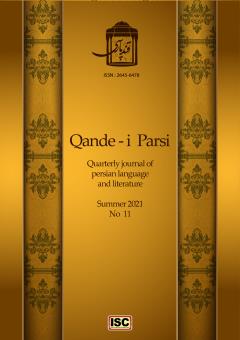Critique of the translation of Hafez Shavarbi poem from Hafez's first and third lyric poems based on Gideon Tori's model
Subject Areas : نقد متون
1 - . Assistant Professor of Islamic Azad University, Pars Abad Moghan Branch
Keywords: : Hafez Shirazi, Translation of Poetry, Criticism, Amin Al-Shawarbi, Ghazal, Gideon Tori.,
Abstract :
Abstract Many of the outstanding works of Persian literature have been translated into Arabic; Among these works is the translation of Hafez's Divan, translated into Arabic by the powerful Egyptian translator Amin al-Shawarbi. This translation has translated fourteen of Shiva Khajeh Shirazi's lyric poems into poems and translated the rest into prose. Given the difficulty of translating poetry and the lack of balance between the source text and the destination text, it is necessary to evaluate such translations with destination-oriented approaches, according to which Gideon Tori's model and theory are based on this approach. In this theory, translation and its constructive and destructive changes are examined in several layers. Thus, the present study, considering the difficulty of translating the poem and the special importance of Hafez's sonnets, which have a different language and interpretation, examines the translation of the poem "Amin Al-Shorabi" from the first sonnet (Ala or Ayha Al-Saqi ...) and the third. (If it leaves Shirazi ...) Hafez, in the light of Gideon's touristic vision, pays attention. Findings show that the translation of the poet's work is very difficult, which causes a lot of slips, Amin al-Shawarbi has done a commendable job, and the slips of his poetic translation are in line with Gideon's network's destination orientation theory. Gives some differences to the translator, it's small. But these translations, in some cases, have destructive changes, destroying the beauty of the text and reversing the meanings and content of the verses, which cannot be easily overlooked.
منابع ومصادر الف) منابع فارسی و عربی احمدي، محمد رحيم، (1392)، «آنتوان برمن و نظريه گرايش¬هاي ريخت¬شکنانه»، دو فصلنامه نقد زبان و ادبيات خارجي، سال ششم، شمارۀ 10، (پیاپی 68).
بهنام، مینا (1389). «استعارۀ مفهومی نور در دیوان شمس»، فصلنامۀ علمی- پژوهشی نقد ادبی، سال 3، شمارة 10، 114-91
توری، گیدئون، ترجمه مهدی ابراهیمی (2011)، ماهیت و نقش هنجارها در ترجمه : در پایگاه www.motarjemonline.com
جلالیان، عبدالحسین (1379)، شرح دیوان حافظ، تهران: یزدان، چ1
حافظ شیرازی، (1393)، دیوان حافظ: نسخه علامه قزوینی و دکتر قاسم غنی، تهران: نشر شقایق.
ــــــــــــــ (1380ش)؛ ديوان اشعار. محقق: ناهيد فرشادمهر، تهران: گنجينه.
ـــــــــــــــ (1990م) ديوان أشعار. مترجم أمين الشواربي، تهران: مهرأنديش.
خزاعی، علیرضا (1394)، تأثیر هنجارها بر روند ترجمه (موردپژوهی: ترجمه های معاصر قرآن مجید)، مطالعات زبان و ترجمه سال چهل و هشتم پاییز 1394 شماره 3
عبّود، عبده (1999م)؛ الأدب المقارن، مشکلات و آفاق، اتحاد الکتاب العرب: سورية.
گنتزلر، ادوین (1393)، نظریه های ترجمه در عصر حاضر، تهران: هرمس
ب) منابع لاتین Toury, Gdeon, (1987), Translation Across Cultures.New Delhi: Bahri Publications
Toury, Gideon (1980), in search of atheory of translation, tel aviv: the porter instityte for poetics and semiotics


